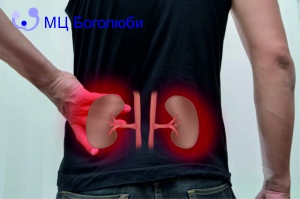Chronic pyelonephritis – is a protracted inflammation of the kidneys and renal pelvis. The pathological process leads to progressive degeneration and atrophy of the organ. In advanced cases, it can cause a decrease in renal function (chronic renal failure). Unlike the acute form, which manifests itself as a single and sudden episode after a bacterial infection, the chronic form develops over a long period of time.
Risk Factors
Some factors predispose to the disease. So the presence of structural or functional disorders of the urinary tract makes a person more susceptible to kidney infection.
Often, chronic pyelonephritis begins unnoticed and is diagnosed when the lesions have reached late stages. In adult patients, recurrent infection plays a fundamental role in the onset of a chronic form. This may be due to two reasons: reflux nephropathy and obstructive pyelonephritis.
In patients with anatomical pathologies, the disease begins in childhood. Severe reflux leads to scarring in the kidneys.
The main risk factors for the disease:
- anatomical and functional changes;
- tumors, stenosis, bilateral renal calculi;
- vesicoureteral reflux;
- any factors that predispose to repeated infections (diabetes, neurogenic urinary incontinence, etc.)
Symptoms
The disease rarely causes any obvious symptoms, and is diagnosed already with the appearance of signs of renal failure. In other cases, the first signs are nonspecific symptoms such as fatigue, loss of appetite, nausea, vomiting, and headache.
The disease further manifests itself as constant pain in the abdomen and side, clinical signs of infection (fever, weight loss). Pressure may increase and blood in the urine may appear, burning sensation during urination and an increase in the frequency of urination.
Diagnosis
Diagnosis of chronic pyelonephritis presents certain difficulties. If laboratory tests were given in the inactive phase of the disease, but it is likely that their results will be normal.
Physical examination of the patient reveals generalized and localized muscle pain with pressure on the sides of the abdomen. If there is a suspicion of a urinary tract infection, urine culture with an antibioticogram is prescribed to assess the sensitivity of microorganisms to antibiotics. A urinalysis can detect the presence of proteins (proteinuria, albuminuria).
A blood test allows you to identify signs of progressive inflammation - a high erythrocyte sedimentation rate, an increase in white blood cells, etc. Ultrasound indicates asymmetric contours of the kidneys.
Complications and prognosis
Evolution of the disease can cause pyonephrosis, urosepsis, focal glomerulosclerosis and paranephritis. Surgery regarding paranephritis is successfully carried out by surgeons of the Bogoliuby MC.
A rare variant of chronic pyelonephritis is xanthogranulomatous pyelonephritis with severe renal destruction and a clinical picture that resembles renal cell carcinoma.
Most patients develop scar tissue in the kidneys and organ atrophy. If adequate treatment is started on time, the disease ceases to progress towards kidney failure.
Treatment and prevention
In the presence of anatomical abnormalities, it makes sense to resort to surgical intervention. In the case of urinary tract obstruction, infections often prove resistant to therapy and tend to recur. You can try to destroy the pathogen with antibiotics, followed by long-term maintenance therapy with low doses (up to 3-6 months) of the drug. In severe forms of unilateral chronic pyelonephritis, surgical removal of a diseased kidney is indicated.
Preventive measures for the disease include: therapy that can eliminate any acute urinary tract infection and remove obstructions to the outflow of urine (bilateral renal calculi, stenosis, etc).

















